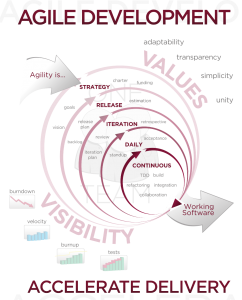Agile principles in digital marketing and acquisition
Digital Marketing Innovation ,Digital Strategy ,Digital Transformation ,Past ExperienceMarch 24, 2013
cezanne
 In the past decade or two, I’ve had the opportunity to truly explore and learn more about the “supply chain” of digital marketing through the lens of an agency and from the view of an in-house digital marketing executive. I’ve also had the opportunity to work within the top most important verticals such as Financial Services, Travel & Hospitality and Retail and learn about the opportunities and challenges each have faced to deliver high-fidelity digital strategy to drive business growth.
In the past decade or two, I’ve had the opportunity to truly explore and learn more about the “supply chain” of digital marketing through the lens of an agency and from the view of an in-house digital marketing executive. I’ve also had the opportunity to work within the top most important verticals such as Financial Services, Travel & Hospitality and Retail and learn about the opportunities and challenges each have faced to deliver high-fidelity digital strategy to drive business growth.
What I’ve learned is that in every experience I couldn’t help seeing a tale of two cities, on one hand organizations stumbling into adopting agile software development methodologies while on the other hand, marketing organizations working to adopt waterfall methods.
Ironically, real-time digital marketing is the very essence of what agile is all about, how else could you possibly deliver on its promise, operationally and to scale up? We just don’t think to apply the very ingredients that have made agile a success in software and product development the past decade to marketing and in particular to digital transformation.
That got me to thinking, why not share my view and craft principles that have helped me and cross-functional teams where ever I’ve been to balance and deliver the productivity, quality and delivery of great service, particularly, if you think about service as a software. The leap then to applying great software development principles is easier to digest. Would love your comments or thoughts and of course before I do that, I thought it’d be good for me to copy/paste Wikipedia’s description of Agile Development:
“Agile software development is a group of software development methods based on iterative and incremental development, where requirements and solutions evolve through collaboration between self-organizing, cross-functional teams. It promotes adaptive planning, evolutionary development and delivery, a time-boxed iterative approach, and encourages rapid and flexible response to change. It is a conceptual framework that promotes foreseen interactions throughout the development cycle. The Agile Manifesto[1] introduced the term in 2001.” Source: Wikipedia
A few prerequisites to align on within your organization:
a) Clearly define who your customers are. Invariably they will be the consumers of the work your team delivers
b) Establish what your service, product and deliverable (example deliverable could be a report) are meant to provide
c) Facilitate feedback and change
Principles for Digital Marketing In An Agile World
- Our highest priority is to satisfy the customer through rapid and continuous delivery of valuable services and deliverables
- Welcome changing requirements, even late in development. Agile processes harness change for the customer’s competitive advantage.
- Deliver high quality working services and deliverable frequently, from a couple of weeks to a couple of months, with a preference to the shorter timescale and rhythm.
- Business people, technology, analyst and developers must work together daily throughout a project.
- Build projects around motivated team members. Provide them the environment and support they need, and trust them to get the work done.
- Make face-to-face conversations mandatory as its the most efficient and effective method of conveying information to and within a team.
- Functional services and regular deliverable is the primary measure of progress.
- Agile processes promote sustainable development. The sponsors, developers, and users should be able to maintain a constant pace indefinitely.
- Continuous attention to technical excellence and good design enhances agility.
- Simplicity–the art of maximizing the amount of work not done–is essential.
- The best architectures, requirements, and designs emerge from self-organizing teams.
- At regular intervals, the team should reflect on how to become more effective, then tune and adjust its process and behavior accordingly.
- Communicate what’s work and what has not including how the team will adjust it’s process and behavior
Update June 23, 2013: CMO.com published an interesting piece a couple of months after my post, unrelated of course, that I thought I’d share. The gist is similar, however, it’s primarily agile in marketing versus Agile In Action: How Four Brands Are Using Agile Marketing